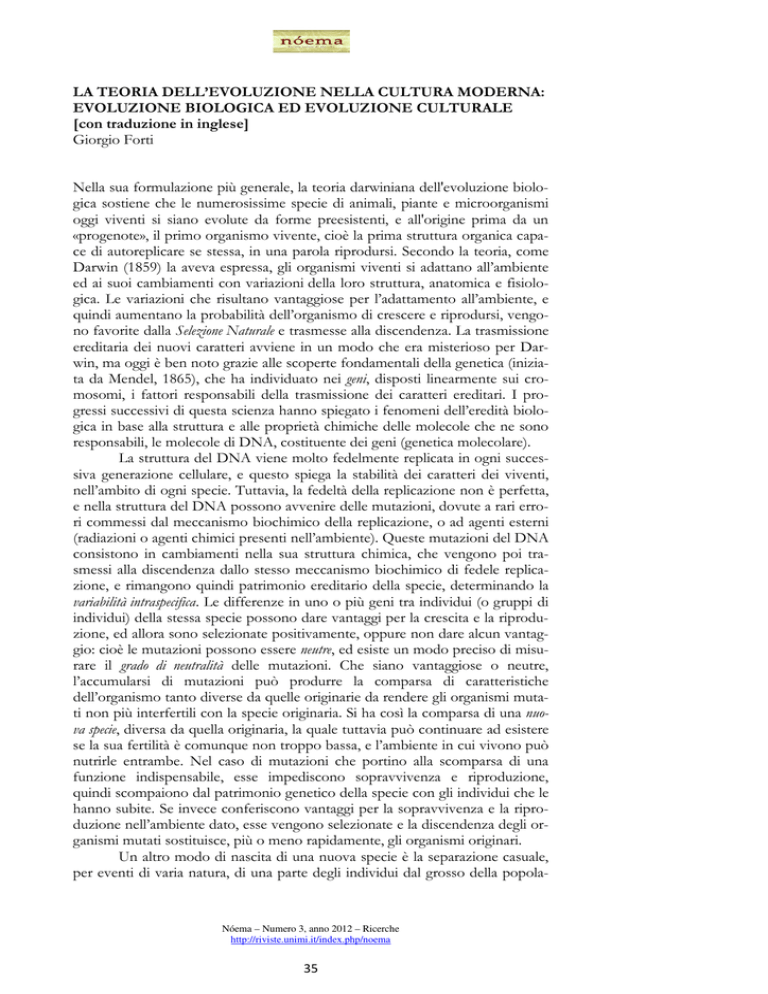
LA TEORIA DELL’EVOLUZIONE NELLA CULTURA MODERNA:
EVOLUZIONE BIOLOGICA ED EVOLUZIONE CULTURALE
[con traduzione in inglese]
Giorgio Forti
Nella sua formulazione più generale, la teoria darwiniana dell'evoluzione biologica sostiene che le numerosissime specie di animali, piante e microorganismi
oggi viventi si siano evolute da forme preesistenti, e all'origine prima da un
«progenote», il primo organismo vivente, cioè la prima struttura organica capace di autoreplicare se stessa, in una parola riprodursi. Secondo la teoria, come
Darwin (1859) la aveva espressa, gli organismi viventi si adattano all’ambiente
ed ai suoi cambiamenti con variazioni della loro struttura, anatomica e fisiologica. Le variazioni che risultano vantaggiose per l’adattamento all’ambiente, e
quindi aumentano la probabilità dell’organismo di crescere e riprodursi, vengono favorite dalla Selezione Naturale e trasmesse alla discendenza. La trasmissione
ereditaria dei nuovi caratteri avviene in un modo che era misterioso per Darwin, ma oggi è ben noto grazie alle scoperte fondamentali della genetica (iniziata da Mendel, 1865), che ha individuato nei geni, disposti linearmente sui cromosomi, i fattori responsabili della trasmissione dei caratteri ereditari. I progressi successivi di questa scienza hanno spiegato i fenomeni dell’eredità biologica in base alla struttura e alle proprietà chimiche delle molecole che ne sono
responsabili, le molecole di DNA, costituente dei geni (genetica molecolare).
La struttura del DNA viene molto fedelmente replicata in ogni successiva generazione cellulare, e questo spiega la stabilità dei caratteri dei viventi,
nell’ambito di ogni specie. Tuttavia, la fedeltà della replicazione non è perfetta,
e nella struttura del DNA possono avvenire delle mutazioni, dovute a rari errori commessi dal meccanismo biochimico della replicazione, o ad agenti esterni
(radiazioni o agenti chimici presenti nell’ambiente). Queste mutazioni del DNA
consistono in cambiamenti nella sua struttura chimica, che vengono poi trasmessi alla discendenza dallo stesso meccanismo biochimico di fedele replicazione, e rimangono quindi patrimonio ereditario della specie, determinando la
variabilità intraspecifica. Le differenze in uno o più geni tra individui (o gruppi di
individui) della stessa specie possono dare vantaggi per la crescita e la riproduzione, ed allora sono selezionate positivamente, oppure non dare alcun vantaggio: cioè le mutazioni possono essere neutre, ed esiste un modo preciso di misurare il grado di neutralità delle mutazioni. Che siano vantaggiose o neutre,
l’accumularsi di mutazioni può produrre la comparsa di caratteristiche
dell’organismo tanto diverse da quelle originarie da rendere gli organismi mutati non più interfertili con la specie originaria. Si ha così la comparsa di una nuova specie, diversa da quella originaria, la quale tuttavia può continuare ad esistere
se la sua fertilità è comunque non troppo bassa, e l’ambiente in cui vivono può
nutrirle entrambe. Nel caso di mutazioni che portino alla scomparsa di una
funzione indispensabile, esse impediscono sopravvivenza e riproduzione,
quindi scompaiono dal patrimonio genetico della specie con gli individui che le
hanno subite. Se invece conferiscono vantaggi per la sopravvivenza e la riproduzione nell’ambiente dato, esse vengono selezionate e la discendenza degli organismi mutati sostituisce, più o meno rapidamente, gli organismi originari.
Un altro modo di nascita di una nuova specie è la separazione casuale,
per eventi di varia natura, di una parte degli individui dal grosso della popola-
Nóema – Numero 3, anno 2012 – Ricerche
http://riviste.unimi.it/index.php/noema
35
Giorgio Forti, La teoria dell’Evoluzione nella cultura moderna
zione della specie. In tal modo i «migranti», che già potevano differire per le diverse varianti di alcuni geni dalla loro distribuzione media nella specie, non si
incontrano più con il ceppo originario: la lontananza li separa e si riproducono
accoppiandosi solo tra loro. In tal modo le due popolazioni non possono più
mescolare i loro geni: sono «geneticamente segregate», e si diversificano sempre
più, per mutazioni che avvengono indipendentemente nelle due popolazioni,
anche se i caratteri che le differenziano non danno alcun vantaggio selettivo,
sono cioè «neutri» dal punto di vista dell’adattamento all’ambiente. Le differenze possono portare, in un certo numero di generazioni, alla perdita
dell’interfertilità, che è alla base della definizione di specie: è nata così una nuova specie per deriva genetica (genetic drift).
La teoria dell’Evoluzione ha avuto molti adattamenti in seguito alle nuove conoscenze del XX secolo, dalle quali sono venute le prove più «definitive» a suo favore,
ed è diventata una delle idee basilari del nostro sapere scientifico. Essa ha avuto importanti effetti non solo su conoscenze specifiche, ma anche sul nostro modo di
pensare. Eppure, di rado una teoria ha suscitato tante polemiche, nate prevalentemente fuori dall’ambiente scientifico. Il motivo è che il tema dell’origine e delle
modificazioni del mondo e della vita è stato oggetto non soltanto di riflessioni
scientifiche, ma anche, e molto prima, di racconti mitologici e di interpretazioni religiose. Le religioni monoteistiche fanno dell’origine dell’Universo e della vita il punto centrale dell’attività creatrice di Dio, con conseguenze fondamentali anche sui
doveri dell’Uomo: la creazione tutta, e la creazione dell’Uomo in particolare, testimoniano il «piano intelligente» di Dio creatore. Nel caso della religione cattolica, il
teologo Joseph Ratzinger, poi divenuto papa Benedetto XVI, ha aderito, a modo
suo, alla visione evoluzionistica nel 1969, ammettendo che le prove scientifiche a
suo favore sono ineludibili e dicendo che l’idea creazionista «è diventata insostenibile», e che la «fede» nella creazione include «l’essere» dell’evoluzionismo (J. Ratzinger,
Fede nella Creazione e teoria dell’Evoluzione, in Wer ist das eigentlich Gott, Munchen 1969).
Si deve tener presente che la teoria dell’Evoluzione non è necessariamente legata alle correnti ipotesi sull’origine della vita sulla Terra. L’evoluzione biologica è una teoria autonoma, basata su osservazioni ed esperimenti, ed è anche teoricamente ben
fondata. Altrettanto non si può dire dell’origine della vita sulla Terra, per la quale
un’ipotesi esiste, molto ragionevole sulla base delle nostre conoscenze di chimica e
fisica, ma priva di evidenza sperimentale.
L’Evoluzione a livello molecolare: la biologia molecolare dei geni
Le prove a favore della moderna teoria dell’evoluzione vengono dalla biogeografia, dalla paleontologia, dall’anatomia comparata, dall’embriologia, dalla biochimica, dalla biologia dello sviluppo, e costituiscono un insieme che rende la
teoria una delle più solide della scienza moderna, ancorché in continua evoluzione per l’apporto ad essa di nuove evidenze sperimentali. Nel corso del tempo si sono accumulate tante e tali prove che è impossibile enumerarle tutte in
poco spazio.
Una prova decisiva è venuta dalla biologia molecolare, ed è la scoperta
della struttura chimica responsabile dell’informazione genetica, che risiede nella
sequenza delle basi del DNA, e ha rivelato la universalità del linguaggio genetico
(impropriamente chiamato «codice» genetico) su di essa basato, uguale in tutti
gli organismi, dai microrganismi all’Uomo: alla sequenza di tre basi nel DNA
corrisponde un aminoacido nella sequenza di aminoacidi nelle proteine. Le
modificazioni che la molecola del DNA può subire a causa del livello di errore
Nóema – Numero 3, anno 2012 – Ricerche
http://riviste.unimi.it/index.php/noema
36
Giorgio Forti, La teoria dell’Evoluzione nella cultura moderna
insito nel meccanismo stesso della sua riproduzione, o per azione di diversi fattori ambientali (radiazioni, agenti chimici, ecc.), hanno corrispondenza lineare
nella modificazione della struttura delle proteine (gli effettori di tutte le funzioni biologiche) e sono in grado di fornire la base razionale per spiegare la variabilità intraspecifica, ed anche le differenze tra le specie e le derivazioni filogenetiche delle specie viventi, anche se la costruzione di un completo albero genealogico è ancora molto lontana. Le alterazioni chimiche del DNA sono casuali
(avvengono secondo la statistica degli eventi rari): casuali sono gli errori nella
duplicazione del DNA, di cui si conoscono i meccanismi biochimici; e casuale
è il sito, nel lungo tratto di molecola di DNA che costituisce un gene, in cui
può avvenire l’alterazione, anche da parte di agenti esterni. Queste alterazioni
chimiche coincidono con le mutazioni dei geni, che si manifestano poi nel fenotipo (i «caratteri» dell’organismo, quale ci appare anche macroscopicamente). Un
esperimento classico di mutazione casuale di un gene batterico che conferisce
resistenza ad un virus e si manifesta solo quando la cultura dei microrganismi è
esposta al virus (selezione naturale operata dall’ambiente in cui sia presente il virus) è stato eseguito da Luria e Delbruck (1), e dimostra che la selezione naturale opera dopo l’avvenimento (del tutto casuale) della mutazione, che può essere avvenuta migliaia di generazioni prima. In presenza del virus, solo i batteri
mutati sopravvivono (circa 1 su 10 milioni, nell’esperimento citato) e la loro discendenza sarà costituita solo da resistenti, fino a quando sia presente
nell’ambiente il virus. È questo un rilevante esempio di come un evento casuale
fa parte di un «piano intelligente» che consente alla specie di sopravvivere in
condizioni avverse (la comparsa del virus nell’ambiente). Quando il virus
scompaia, avvengono e sopravvivono in alcuni degli individui mutazioni (prive
di conseguenze in assenza del virus) che sopprimono la resistenza a questo
nemico.
Nel 1988 è stata fatta una scoperta di grande rilievo (2) per la teoria
dell’Evoluzione: in certe condizioni di stress possono prodursi in singole cellule batteriche mutazioni che consentono alla cellula di uscire da quello specifico
stato di stress. Cioè, in questi casi particolari (in seguito ne sono stati scoperti
molti altri), le condizioni ambientali, un ben definito tipo di stress che impedisce alle cellule di riprodursi ma non ne provoca la morte immediata come nel
caso di Luria e Delbruck, determinano la mutazione («mutazione indotta» o «adattativa»), piuttosto che selezionare mutanti preesistenti. In altre parole, la selezione darwiniana opera oltre che diacronicamente, attraverso le generazioni,
anche sincronicamente, nella cellula sottoposta a selezione. Il meccanismo di
questo fenomeno, ancora in corso di studio (3), potrebbe consistere in
un’aumentata frequenza di mutazioni geniche nelle cellule esposte allo stress in
assenza di divisione cellulare (replicazione del DNA), oppure nell’amplificazione e mutazione del gene da selezionare da parte della condizione di stress,
finché il mutante diventi capace di superare quello specifico stress, e quindi di riprodursi e trasmettere alla progenie il nuovo carattere acquisito. Si osserva
quindi la trasmissione ai discendenti di un carattere acquisito, come voleva
l’evoluzione secondo Lamarck, sia pure avvenuto con meccanismo casuale,
darwiniano.
La mutazione adattativa è stata osservata anche in organismi superiori:
in tal senso infatti si possono interpretare i meccanismi di formazione di anticorpi specifici nella reazione immunitaria: nelle cellule del sangue addette alla
difesa immunitaria, si formano geni specificamente addetti alla sintesi di antiNóema – Numero 3, anno 2012 – Ricerche
http://riviste.unimi.it/index.php/noema
37
Giorgio Forti, La teoria dell’Evoluzione nella cultura moderna
corpi, in risposta allo stimolo ambientale dato dalla presenza dell’antigene invasore. In questo caso, il nuovo gene che informa la sintesi dell’anticorpo specifico viene «montato» utilizzando DNA già esistente nella cellula, ma il processo
richiede la mutazione, con altissima frequenza, di alcune parti del gene, indotta
dalla presenza dello specifico antigene. Il nuovo gene è poi trasmesso a tutta la
discendenza cellulare dei leucociti che hanno subito la «mutazione adattativa»
(ma non a quella dell’individuo pluricellulare di cui essi fanno parte).
Il complesso processo dello sviluppo embrionale e differenziamento
dei diversi tessuti ed organi degli organismi pluricellulari viene oggi studiato a
livello molecolare. Questo processo consiste nella regolazione, sotto il controllo di geni regolatori ma sotto l’influenza di fattori ambientali, del tempo e luogo di espressione dei geni che, sebbene tutti presenti nel genoma di tutte le cellule dell’organismo che derivano dalla stessa cellula, l’uovo fecondato, sono espressi o repressi in cellule diversamente ubicate, che così si differenziano in
una moltitudine di cellule molto diverse tra loro, quanto lo sono i neuroni dalle
cellule del fegato o della pelle. Questo processo epigenetico passa per ben definite
tappe, che possono essere ereditate dalla discendenza per mezzo di diversi
meccanismi (4), ma operano attraverso modificazioni del DNA (come la metilazione di citosine) che non alterano il genoma ma che influenzano l’espressione dei geni, la quale può essere ereditata se la modificazione del DNA è
conservata nei gameti. Le vie alternative di differenziamento possono dunque
avere grande importanza per l’evoluzione perché possono essere ereditate. Così, alcuni tipi di caratteri acquisiti vengono ereditati, come sosteneva Lamarck.
Gli ormai numerosi esperimenti di tipo cairnesiano su batteri, una riconsiderazione del meccanismo di «mutazione adattativa» nella reazione immunitaria e la dimostrata ereditabilità di stati raggiunti nell’epigenesi (gli eventi
di differenziazione di tessuti ed organi che hanno luogo dopo la fecondazione
dell’ovulo) sono la premessa per il superamento dell’incompatibilità, sin di recente considerata assoluta, delle concezioni darwinista e lamarckiana dell’evoluzione.
L’evoluzione della mente e della cultura
I recenti progressi delle conoscenze sulla struttura e funzione del sistema nervoso centrale hanno rinnovato l’attenzione sulla relazione tra evoluzione biologica ed evoluzione culturale, consentendoci di definire meglio il ruolo del cervello nelle attività conoscitive e in quelle del linguaggio, della coscienza e
dell’autocoscienza, che sono alla base della cultura umana.
Fra i problemi che hanno suscitato maggior interesse nella storia del
pensiero umano vi sono quelli dell’origine del «libero arbitrio» e della relazione
mente-corpo. Se tutto il mondo naturale, di cui il corpo umano (compreso il
cervello) fa parte, obbedisce alle leggi fisiche, come si spiegano l’esercizio del
libero arbitrio e la capacità del pensiero di determinare i comportamenti umani? È ben provato che il cervello e la sua struttura complessiva si sono evoluti
come qualsiasi altro organo del corpo degli animali. Tuttavia, quando sono
comparse come risultato del processo evolutivo le strutture che caratterizzano
il cervello umano, capaci delle nuove «prestazioni» quali il linguaggio sinteticosimbolico, la conoscenza sintetica e l’autocoscienza (non presenti negli altri animali), è iniziato un nuovo modo di evoluzione: l’evoluzione culturale, cioè la
Storia dell’umanità. Questa procede a velocità enormemente maggiore rispetto
all’evoluzione biologica, perché non abbisogna di mutazioni di geni accumulate
Nóema – Numero 3, anno 2012 – Ricerche
http://riviste.unimi.it/index.php/noema
38
Giorgio Forti, La teoria dell’Evoluzione nella cultura moderna
e selezionate per generazioni, ma utilizza le facoltà dell’apprendimento individuale, rese possibili dalla struttura del cervello, e la capacità di trasmettere
quanto appreso agli altri componenti della specie umana. Questa trasmissione
utilizza il linguaggio sintetico-simbolico e tutti i mezzi che l’arte e la tecnologia,
dalle pitture rupestri ai moderni computers, forniscono. Privilegiata è la trasmissione di pensieri e sentimenti tramite l’espressione artistica in tutte le sue
forme, che è in grado di scavalcare le barriere linguistiche, utilizzando intuitivamente il linguaggio universale di cui tutta la specie è dotata, essendo una funzione strutturale del cervello.
La capacità di concepire valori, derivata dalla capacità di conoscenza
sintetica e di linguaggio sintetico-simbolico, è alla base dell’etica individuale e
sociale e delle strutture delle società umane.
Nuove prospettive sulla relazione mente-corpo sono state aperte di recente dalla neurobiologia: si tratta dell’evidenza che i meccanismi di generazione della struttura e del funzionamento degli organi ed apparati fisiologici del
corpo umano, compreso il cervello, non sono sufficienti a formare il sistema
mente-cervello, nel senso che i primi sono prodotti mediante la decodificazione del DNA ereditato dai genitori, che include l’informazione per tutte le strutture e la programmazione dello sviluppo del cervello durante la vita embrionale, mentre il sistema mente-cervello è prodotto durante l’attività sua propria, in
ogni individuo della specie. Un’attività che sembra iniziare durante la vita intrauterina, per prolungarsi tutta la vita, e consiste nell’interazione con
l’ambiente esterno, quello fisico e, soprattutto, quello costituito dagli altri esseri
umani e dalle strutture sociali da essi formate. Queste interazioni generano, è
oggi accertato, reti neuronali responsabili dei vari processi di apprendimento, di
immaginazione, di scelte estetiche e morali, di interazioni affettive. Ogni neonato nasce privo di conoscenze e deve gradualmente generare nel proprio sistema mente-cervello le strutture che accompagnano la transizione dallo stato
neonatale allo stato adulto e che dipendono da graduali e specifici processi di
auto-organizzazione neuronale. Lo sviluppo del sistema mente-cervello richiede pertanto la transizione da una condizione iniziale in cui sono presenti solo le
reti neuronali dedicate alle funzioni fisiologiche interne e di recezione di alcuni
segnali esterni, a una condizione in cui sono presenti migliaia di miliardi di
connessioni sinaptiche fra i neuroni: la transizione riflette la costruzione, sulla
base delle esperienze vissute, di un insieme estremamente complesso di reti
neuronali.
Secondo Edelman (5), il processo di formazione delle reti neuronali è di
tipo evoluzionistico, cioè fondato sulla combinazione di eventi casuali (la generazione di connessioni sinaptiche fra neuroni) e sulla successiva selezione, per
«rafforzamento», delle reti neuronali utilizzate con successo dalla mente. Il «rafforzamento» le sottrae al processo di «morte programmata» («apoptosi»), dovuto all’attività di specifici geni, simili a quelli (o gli stessi) che presiedono anche
al differenziamento durante lo sviluppo embrionale. L’autorganizzazione delle
mappe di reti neuronali della mente è un fenomeno condizionato dallo specifico contesto in cui si realizza il processo di selezione naturale, in cui l’adattamento all’ambiente consiste nella qualità dei rapporti che l’individuo instaura
con gli altri individui della specie umana, di altre specie e con l’ambiente fisico,
e nel successo di tali rapporti.
Lo sviluppo della mente umana è un processo creativo della singola
persona che si accompagna alla generazione di una grande quantità di nuova e
Nóema – Numero 3, anno 2012 – Ricerche
http://riviste.unimi.it/index.php/noema
39
Giorgio Forti, La teoria dell’Evoluzione nella cultura moderna
imprevedibile informazione alla quale il concetto di persona umana è legato:
imprevedibile perché ad ognuno arrivano segnali diversi, ed anche gli stessi segnali che provengono dal mondo esterno, compresi quelli che vengono da
molto lontano nel tempo e nello spazio, vengono interpretati e memorizzati (in
reti neuronali) in modo diverso dalle diverse persone, in funzione della loro individuale struttura genetica e delle precedenti esperienze. Di conseguenza, i
comportamenti di ogni essere umano sono largamente imprevedibili così come
sono imprevedibili i risultati di qualsiasi processo di variazione-selezione. Le
reti neuronali del sistema mente-cervello sono strutture dinamiche nel senso
che qualsiasi tipo di apprendimento e di attività mentale è accompagnato da
una parziale ristrutturazione delle reti neuronali create precedentemente. La
personalità di ogni essere umano è quindi il risultato della sua storia che include
la sua eredità genetica, per le influenze che essa ha sulla struttura dei singoli
neuroni e delle sinapsi mediante le quali essi possono comunicare, e la interazione con il mondo al quale è esposto durante la vita fetale e, dalla nascita in
poi, per tutta la vita. La storia personale di ogni essere umano è poi conservata
nell’organizzazione del suo sistema mente-cervello e nella successione delle sue
modificazioni: in sintesi, la nostra capacità di conoscere ed intendere, amare o il
suo contrario, sentire i rapporti con gli altri viventi e con il resto del mondo fisico, in una parola la nostra «anima», coincide con la struttura del nostro sistema cervello-mente, quale viene costruita nel corso di tutta la vita individuale.
Con la morte dell’individuo, la sua «persona» scompare con la distruzione della
struttura del cervello e di tutto il corpo. Tuttavia, non potrà mai venir cancellato il fatto che quel determinato individuo, e la persona che esso e la sua storia
hanno costruito, siano esistiti per una certa «durata» di tempo: la persona vive
dunque oltre il «suo» tempo, indipendentemente dalla memoria che ne possano
avere gli altri membri della specie.
L’interpretazione evoluzionistica della mente umana, considerando la
cultura come il risultato dell’interazione delle molte persone che la creano (tutti
gli esseri umani), dà ragione della storia dell’umanità, dell’imprevedibilità del
suo futuro, e della «libertà» di ogni persona. La natura del linguaggio umano,
che pur nella diversità delle lingue parlate ha unicità di struttura cerebrale e di
localizzazione encefalica, rende possibile la comunicazione tra i membri della
specie. Non per caso, processo evolutivo e linguaggio umano hanno le stesse
caratteristiche essenziali: ridondanza dei «segni» significativi ed arbitrarietà del
rapporto significante-significato (6). Queste caratteristiche rendono possibile
l’evoluzione libera ed imprevedibile sia degli organismi biologici che dei linguaggi parlati, che sarebbero, l’una e l’altra, impossibili se tutto fosse rigorosamente deterministico. Infatti, è oggi ben noto che vi è ridondanza di sequenze
di basi nel DNA per definire la struttura di ogni unità funzionale (proteina) nel
linguaggio genetico, che strutture un po’ diverse possono svolgere la stessa
funzione nelle proteine, e una varietà di funzioni possono consentire di adattarsi, in modi alternativi, all’ambiente. Così, vi è ridondanza nel rapporto parola-oggetto nel linguaggio parlato; di fonemi e morfemi per comunicare tra gli
individui della stessa area linguistica e tra aree linguistiche. E vi è arbitrarietà
nelle relazioni significante-significato: non vi è infatti alcuna affinità chimica tra
le basi del DNA che costituiscono il «codice» (o meglio, il linguaggio) genetico
e le corrispondenti entità chimiche (gli aminoacidi) che costituiscono l’unità
funzionale, la proteina. Nel linguaggio parlato, le relazioni tra parola significante ed oggetto significato non sono stabilite deterministicamente in base a leggi
Nóema – Numero 3, anno 2012 – Ricerche
http://riviste.unimi.it/index.php/noema
40
Giorgio Forti, La teoria dell’Evoluzione nella cultura moderna
della fonetica né alcuna altra legge, ma cercate, nella storia del linguaggio, per
tentativi: vengono adottate quelle che sono «selezionate» in base alla loro efficacia nel comunicare. Lo stesso linguaggio ha la duplice funzione di mezzo di
comunicazione nell’ambito della specie, e di strumento di rappresentazione
dell’universo per il soggetto che lo usa: il modo in cui ogni essere umano parla
è nello stesso tempo il mezzo mediante cui egli trasmette il suo messaggio agli
altri ed il modo in cui egli rappresenta ciò di cui parla a se stesso.
Bibliografia
1) Luria S.E., Delbruck M. (1943). Mutation of bacteria from virus sensitivity
to virus resistance. Genetics 28: 491-511.
2) Cairns J., Overbaugh J., Miller S.(1988). The origin of mutants. Nature 335:
142-145.
3) Roth J.R, Kugelberg E., Reams A.B, Kofoid E., Andersson D.I. (2006). Origin of mutations under selection: the adaptive mutation controversy. Annual
Review of Microbiology 60: 477-501.
4) Jablonka E., Raz G. (2009). Transgenerational epigenetic inheritance: prevalence, mechanisms and implications for the study of heredity and evolution.
The Quarterly Review of Biology 84 (2): 131-176.
5) Edelman G.M. (1989). The Remembered Present. New York: Basic Books.
6) Forti G. (1977). Structure and evolution of language and of living organisms.
Scientia 112: 55-68.
[English version]
THE THEORY OF EVOLUTION IN CONTEMPORARY CULTURE.
BIOLOGICAL EVOLUTION AND CULTURAL EVOLUTION
Giorgio Forti
In its most general formulation, the darwinian theory of biological evolution
holds that the very large numbers of the plant, animal and microorganisms
species living today have evolved from pre-existing forms of life, at the very
origin from a «progenote», the first living organism, i.e. the first organic structure capable of replicating itself, in a word capable of reproduction.
The theory holds that living organisms adapt themselves to the ambient
and its changes with changes of their anatomical and physiological structure.
The changes that are advantageous for adaptation to the ambient, and therefore increase the probability of the organism to grow and reproduce itself, are
favoured by natural selection and transmitted to the offspring. The hereditary
transmission of any new trait occurs through a mechanism which was mysterious to Darwin, but is well known today thanks to the fundamental discoveries
of the science of genetics (starting with Mendel, 1865), which has found that
the genes, linearly localized on chromosomes, are responsible for the heredity
of characters. The subsequent progresses of this science have explained the
phenomena of biological heredity on the basis of the structure and chemical
properties of the DNA molecules, which are the constituent of the genes re-
Nóema – Numero 3, anno 2012 – Ricerche
http://riviste.unimi.it/index.php/noema
41
Giorgio Forti, La teoria dell’Evoluzione nella cultura moderna
sponsible for the determination of the inherited characters (molecular genetics).
The structure of DNA is replicated with precision at any cellular generation, so that the daughter cells inherit the DNA of the parent cells. However, a low level of error is intrinsic in the replication mechanism, which introduces changes (mutations) in the structure of DNA. These mutations can also
be caused by external agents, such as ionising radiations or chemicals which
may be present in the ambient. The mutations are changes in the chemical
structure of DNA which are transferred to the daughter cells, and therefore are
conserved in the genetic legacy (the «genome») of the species, and determine
the intraspecific variability: not only, but the accumulation of mutations can
generate properties so different from the original ones as to render the mutated
organisms no more interfertile with the original species. A new species is born
in this way, different from the original one. The latter can however survive, if
its fertility is not too low, and the ambient where they live can offer food and
resources for both. If the mutations abolish a function absolutely required for
life, they prevent growth and reproduction, therefore they disappear from the
genetic inheritance of the species with the death of the mutated individuals.
Conversely, if they provide advantages for survival and reproduction in the
given ambient, the mutations are selected and the offspring of the mutants organisms will outnumber and eventually substitute the original organisms.
A different way of originating a new species is the casual separation,
caused by accidental events, of a number of individuals from the main population of a species, so that the «migrants» are segregated from the rest of the
population. The migrants may be a relatively small number of individuals as
compared to the whole population, and have a different ratio of the different
variants (alleles) of some genes with respect to the whole population. Furthermore, the segregation forces them to couple only among themselves, so that
they can no more mix their genes with the original population, and they become more and more genetically different because of mutations which occur
independently in the two populations, even if the characters which differentiate
them do not provide any selective advantage, i.e. are «neutral» for the adaptation to the environment. These genetic differences can bring to the loss of the
interfertility ( which is fundamental to define a species) in a number of generations: a new species is so born through «genetic drift».
The theory of Evolution underwent many adaptations following the
new discoveries of the xxth century, from which came the most convincing evidences in its favour, and it became one of the basic ideas of our scientific
knowledge. It had important effects not only on specific concepts, but on our
way of thinking as well. However, never a theory started so many controversies, originated mostly outside of the scientific community. The reason for this
is that the origin of the world and of life and their modifications has been the
object not only of scientific investigations, but also, much earlier, of mythological tales and of religious interpretations. The monotheist religions consider
the origin of the Universe and of life a fundamental act of God, with strong
consequences on the recognition by man and on his ethical behaviour. In the
case of the catholic religion, the theologian Joseph Ratzinger, who became
Pope Benedict XVI, accepted in his own way the evolutionistic point of view
in 1969, recognizing that the scientific evidence in its favour is overwhelming,
and saying that the «creationist» idea is today impossible to maintain: the «faith
Nóema – Numero 3, anno 2012 – Ricerche
http://riviste.unimi.it/index.php/noema
42
Giorgio Forti, La teoria dell’Evoluzione nella cultura moderna
in creation» must include the «being» of evolutionism (J. Ratzinger, Faith in
Creation and theory of Evolution, in the essays Wer ist das eigentlich Gott, Munchen
1969).
It should be remembered that the theory of Evolution is not necessarily
linked to the current hypotheses on the origin of life on earth. Biological Evolution is an autonomous theory with solid bases on observations and experiments, and is theoretically well founded. The same is not true for the origin of
life, for which an hypothesis exists, which is reasonable on the basis of current
knowledge of chemistry and physics, but has no compelling experimental evidence.
The Evolution at the molecular level: molecular biology of the genes
The evidence in favour of the modern Darwinian theory comes from biogeography, paleontology, comparative anatomy, embryology, biochemistry, developmental biology, and constitutes a body of evidence which makes the theory
one of the most strong of modern science. In the course of time, so many arguments have accumulated that it is impossible to describe them in short.
The most recent, and conclusive, came from molecular biology and is
based on the discovery of the chemical structure responsible for genetic information, which resides in the bases sequence of DNA. It has been demonstrated that the genetic language (improperly called «genetic code») is universal: it is
the same in all organisms, from microorganisms to humans and is based on
the sequence of three bases in DNA which corresponds to an aminoacid in the
proteins. The modifications that the DNA may undergo because of the low
level of error intrinsic in the mechanism of its replication (ca. 10-9 errors /base)
or through the action of environmental factors, have linear correspondence in
the modification of the structure of the proteins, which are the effectors of all
biological functions. Therefore if DNA is modified, the physiological properties of the organisms are changed and the anatomical properties as well; such
modifications are transmitted to the progeny. These changes provide the rationale to explain the intraspecific variability, as well as the differences between
species, and the possibility to make hypotheses, on statistical bases, on the
temporal sequences of the appearance of species. The chemical modifications
of DNA occur at random: the replication errors are casual, as is evident on the
basis of their known mechanism of occurrence. Also, the site at which any error may occur along the segment of the DNA molecule which corresponds to
a gene is casual. The chemical modifications of DNA coincide therefore with
the mutations of genes, which become manifest in the phenotype (the characters
of the organism as they appear, sometimes also macroscopically).
A classical experiment on random mutation of a bacterial gene conferring resistance to a virus which becomes manifest only when the culture of
bacteria is exposed to the virus (natural selection operated by the environment
where the virus is present) has been performed by Luria and Delbruck in 1943
(1).Those authors have shown that natural selection operates after the occurrence of the event of gene mutation, which is completely casual, and may have
occurred thousands of generations before the selection. Only the mutant bacteria survive (ca. one/107 in this experiment ), and their progeny will be 100%
resistant to the virus, until the virus is present in the ambient. This is a relevant
example of how a random event is part of an «intelligent design» allowing the
species to survive in adverse conditions. If the virus disappears, some of the
Nóema – Numero 3, anno 2012 – Ricerche
http://riviste.unimi.it/index.php/noema
43
Giorgio Forti, La teoria dell’Evoluzione nella cultura moderna
individuals of the population undergo mutations which suppress the resistance
to the virus, but this has no consequences in the absence of the virus.
It is today possible to modify in a programmed mode a gene, by modifying in a specific way and in a specific site the DNA, and observe the change
of functionality of the gene in its phenotypic effects on the cell and its progeny. In pluricellular organisms, if the cell containing the modified gene is in the
germ line (if it is a gamete or a precursor of gametes) the mutation is conserved
in the genome of the species, if it is not eliminated by natural selection. Furthermore, it is feasible to transfer «artificially» a gene (= a segment of DNA)
from an organism to another, even beyond the barrier of species, and observe
the expression of that gene in the recipient organism and in its offspring. This
technique is the basis for the so-called genetic engineering, and the creation of
genetically modified organisms (GMO).
In 1988, a discovery of great relevance for the theory of Evolution has
been made by Cairns and coworkers (2): in certain conditions of stress, bacterial cells can undergo mutations which allow the cells to overcome that specific
condition of stress. In this case (many other cases have been reported since
then) the environmental conditions producing a well defined type of nutritional
stress (which prevents cell growth and reproduction but do not kill them immediately as is the case in the Luria and Delbruck’s experiment reported
above), determine the mutation (adaptive mutation, or induced mutation) rather
than selecting pre-existing mutants. The mechanism of this phenomenon, still
under investigation (see the review by Roth et al.,3), may be an accelerated frequency of gene mutations in the cells exposed to stress in the absence of cell
division (therefore of DNA replication) or the amplification and mutation of
the gene to be selected by the stress condition, till a mutant appears able to
overcome that specific stress, and therefore to reproduce itself and transmit to the
progeny the newly acquired character.
In other words, darwinian selection can operates synchronically, on the
cell subjected to selection, besides the well known diachronic mode through the
generations.
The phenomenon of «adaptive mutation» is observable also in higher
organisms, even if the detailed mechanism is different from the above mentioned bacterial example: the phenomenon of immunity in vertebrates. Certain
specialised cells of the organism have the function of binding macromolecules
(the antigens) recognised as alien to the organism, which can be brought into
contact with the cell by any «intruder» (a bacterium, a virus or other material).
Then the cells multiply rapidly giving rise to a clone of cells endowed with the
capacity to produce an antibody, which is a protein molecule (encoded by a
gene) very specifically reacting with the antigen to neutralise it. This process
involves a reorganization through recombination of several segments of DNA,
already present in the cell, to form a new gene, which codes for the antibody
specific for the antigen. The new gene is inherited by the progeny cells through
the usual mechanism of DNA duplication. In the presence of the antigen, an
«hypermutable» part of the gene (coding for the part of the antibody molecule
specifically binding the antigen) undergoes random point mutations (single base
mutation) with a frequency about one million times higher than the spontaneous mutation rate of the other genes. The antigen (most frequently a pathogen)
acts as a selective agent for the most efficient antibody (the one with the high-
Nóema – Numero 3, anno 2012 – Ricerche
http://riviste.unimi.it/index.php/noema
44
Giorgio Forti, La teoria dell’Evoluzione nella cultura moderna
est affinity for the antigen), and the process leads therefore to a clone of cells
capable of an higher efficiency in the immune defence.
This acquired function is inscribed as a new DNA sequence, a new gene,
in the genome of the cell, and is inherited by the progeny cells which proliferate in the blood of the animal. It may therefore be considered an adaptive mutation of the cells specialized in the defence against intruders, though not of the
individual organism to which these cells belong, because the acquired function
does not reach the germ line. As in the case of the bacterial adaptive mutation,
the mutation which leads to the acquired immunological competence requires
DNA recombination.
This is an important example of the mode in which darwinian evolution, which produced the immune system through a diachronic evolution lasting millions of years, can involve an adaptive mutation and clonal selection in a
cell exposed to a specific antigen during its life time.
The complex process of embryo development and differentiation into
the different tissues and organs of the pluricellular organisms is being investigated at the molecular level. The process consists in the regulation, under the
activity of regulatory genes, of the time and location of expression of genes
which, though all present in the genome of any cell of the organism as they are
all derived from the same cell, the fertilized egg, are expressed or repressed in
differently located cells, which so differentiate into a host of very different
cells, as neurons are different from the cells of liver or the skin. This process,
the epigenesis, goes through well defined steps, which can be inherited by the
offspring through different mechanisms (4), which do not affect the genome
but operate through the modifications of DNA (such as the methylation of
certain cytosines) influencing the expression of genes, which can be inherited
when conserved in the gametes. These different patterns of differentiation may
constitute an important fact in evolution, because they can be inherited. So,
some types of acquired characters can be inherited, as was postulated by Lamarck’s theory of evolution.
The numerous «cairnesian» experiments on bacteria, a reconsideration
of the mechanism of the immunity as an «adaptive mutation» of the cells of the
immunity apparatus, together with the recent evidence for the inheritance of
certain states of differentiation reached during epigenesis constitute an attractive premise to overcoming the incompatibility between the darwinian and the
lamarckian concepts of evolution, which has been considered absolute till very
recently.
The evolution of mind and culture
The recent progresses of knowledge on the structure and functions of the central nervous system have brought into new focus the relationship between biological evolution and cultural evolution. The problems connected with the origin of the free will and of the relationship mind-body are among those considered most interesting in the history of human thought. If all of nature is submitted to physical laws, how can the exercise of free will and the power of
thought to determine human behaviour be explained? It is well established that
the brain and its overall complex structure has evolved as any other organ of
the animal body. However, when the darwinian evolution of the living organisms has led to the structures characterizing the human brain, capable of new
performances such as the synthetic-symbolic language, the synthetic knowledge
Nóema – Numero 3, anno 2012 – Ricerche
http://riviste.unimi.it/index.php/noema
45
Giorgio Forti, La teoria dell’Evoluzione nella cultura moderna
and self-conscience (which are absent in the other animals), a new mode of
evolution has started: the cultural evolution, i.e. the history of humanity. Cultural evolution proceeds at a pace enormously faster than biological evolution,
because it does not require gene mutation and natural selection to accumulate
for many generations, but uses the faculty of individual learning, which is a
property of the structure of the brain, and the ability to exchange knowledge
with the other components of the species. Such exchange utilizes the syntheticsymbolic language, and all the instruments of art and technology, from cavern
paintings to the modern computers. A particularly privileged way of communicating thoughts and feelings is the artistic expression in all its forms, which can
overcome the linguistic barriers utilizing the intuitive universal language which
is a property of our species, being part of the brain structures.
The ability to conceive values, derived from synthetic knowledge and
language, is the basis for the individual and social ethics and of the structure of
human societies.
New openings on the mind-body relationship have been recently provided by neurobiology. The evidence has been provided that the mechanisms
which generate the structure and function of the organs and apparatuses of
human body, including the brain, are not sufficient to form the brain-mind system. Indeed, the former are produced through the decodification of DNA inherited by the parents which includes the information for all the structures and
the program of brain development during embryo life, while the later is produced during its proper activity. An activity which appears to begin during the
intrauterine life, to last along all life, consisting in the interactions with the external ambient: the physical one and, most important, the one provided by the
other human beings and their social structures. These interactions generate, we
have learned it, neuronal networks which are responsible for the different
processes of learning, of imagination, of aesthetic and moral choices and of affective interactions. A baby is born with no cognitions and must gradually generate in his mind-brain system the structures involved in the transition from
the neonatal to the adult state, which depend on gradual and specific processes
of neuronal auto-organisation. The development of the mind-brain system requires therefore the transition from an initial condition in which the only neural networks present are those dedicated to the internal physiological functions
and to the reception of some external signals, to a condition in which billions
of synaptic connections are present among neurons. This transition reflects the
construction of an extremely complicated complex of neural networks, as a
consequence of the experiences of life, associated with the continuous activity
of the brain structures.
According to Edelman (5), the formation of neural networks is an evolutionary process, i.e. it is based on the combination of random events of synaptical connection of neurons followed by the selection, by «reinforcement», of
the networks successfully utilized by the mind. The «reinforcement» prevents
the process of programmed death («apoptosis»), due to the action of specific
genes, similar to those (or the very same) which are involved in the differentiation and development of the embryo. The auto-organization of the neural networks maps of the mind is a process conditioned by the specific context where
the natural selection process occurs, in which the adaptation of the mind to the
ambient consists in the quality of the relations which the individual establishes
with the other individuals of the human species, with other species, and with
Nóema – Numero 3, anno 2012 – Ricerche
http://riviste.unimi.it/index.php/noema
46
Giorgio Forti, La teoria dell’Evoluzione nella cultura moderna
the physical ambient, and in the success of these relations, evaluated in terms of
the subjective desire to communicate or other desires.
The development of human mind is a creative process of the individual
person which proceeds with the generation of a large amount of new and unpredictable information to which the concept of human person is linked. Unpredictable because every person receives different signals, and even the same
signals coming from the world , including those coming from great distances in
space and time, are interpreted and memorized (in neural networks) in different ways by different persons, depending on their different individual genetic
structures and previous experiences. As a consequence the behaviour of any
human being is largely unpredictable, as are the results of any variationselection process. The neural networks of the brain-mind system are dynamic
structures because any kind of learning and of mental activity is accompanied
by a partial restructuration of the network previously created. The personality
of any human being is therefore the result of his history and includes the genetic heredity because of the influence that it has on the structure of the neurons and of the synapses through which they intercommunicate, and the interaction with the external world to which he is exposed since epigenesis, and
subsequently from birth along all his life. The personal history of any human
being is then conserved in the organization of his brain-mind system and in the
succession of its modifications. To summarize, our capacity to learn and understand, to love and hate, to establish relationships with other living beings
and with the rest of the physical world, in one word our soul, coincides with
the structure of our brain-mind system as it is built up during all our individual
life. At the death of the individual, his «person» disappears with the destruction
of his brain and the whole body. However, the very fact will never be cancelled
that any particular individual existed for a certain length of time, with the personality which himself in his history has constructed and defined in time and
space. In this sense, the person survives his time of existence, independently of
the memory that the other members of the species will have of it.
The evolutionistic interpretation of human mind, considering culture as
the result of the interaction of the very large number of persons which contribute to it (all the human beings), accounts for the history of humanity, the
unpredictability of its future and the freedom of each person. The nature of
human language, which beyond the diversity of the spoken languages has a
unique cerebral structure, makes it possible the communication between the
members of the species. It is not fortuitous that biological evolution and the
human language have the same basic properties: redundancy of significants and
arbitrariness of the relationship between the significant and the signification (6).
These properties make possible the free and unpredictable evolution, of the
type that Darwin has conceived, both for biological organisms and the spoken
human languages: this would be impossible if everything were rigidly deterministic. Indeed, it is well known that there is redundancy of base sequences in
DNA to determine the primary structure of the functional units (the proteins)
in the genetic language (the so-called genetic code), that a certain diversity of
structures of proteins may perform the same function, and that different functions can allow to adapt in alternative ways to the same ambient. Similarly,
there is redundancy in the relationship between words and their object in the
spoken language.
Nóema – Numero 3, anno 2012 – Ricerche
http://riviste.unimi.it/index.php/noema
47
Giorgio Forti, La teoria dell’Evoluzione nella cultura moderna
There is arbitrariness in the significant-signification relationship: indeed, in the biological structures there is no chemical affinity between the
bases of DNA which constitute the genetic language and the corresponding
chemical entities (the aminoacids) which form the functional units, the proteins. Similarly, in the spoken language the relationships between the word
(significant) and the object (signification) are not established in a deterministic
way on the basis of some laws of phonetics nor any other law, but rather they
are searched, in the history of language, by trial and error: the ones which are
adopted are selected on the basis of their efficiency to communicate.
The same language has the dual function of means of communication
among the members of the species, and of instrument of representation of the
universe for the person who uses it: the way in which any human speaks is at
the same time the instrument to communicate his message to others and the
way in which he represents to himself the object he is talking about.
References
1) Luria S.E., Delbruck M. (1943). Mutation of bacteria from virus sensitivity
to virus resistance. Genetics 28: 491-511.
2) Cairns J., Overbaugh J., Miller S.(1988). The origin of mutants. Nature 335:
142-145.
3) Roth J.R, Kugelberg E., Reams A.B, Kofoid E., Andersson D.I. (2006). Origin of mutations under selection: the adaptive mutation controversy. Annual
Review of Microbiology 60: 477-501.
4) Jablonka E., Raz G. (2009). Transgenerational epigenetic inheritance: prevalence, mechanisms and implications for the study of heredity and evolution.
The Quarterly Review of Biology 84 (2): 131-176.
5) Edelman G.M. (1989). The Remembered Present. New York: Basic Books.
6) Forti G. (1977). Structure and evolution of language and of living organisms.
Scientia 112: 55-68.
Nóema – Numero 3, anno 2012 – Ricerche
http://riviste.unimi.it/index.php/noema
48

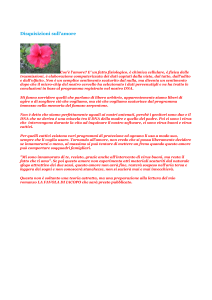
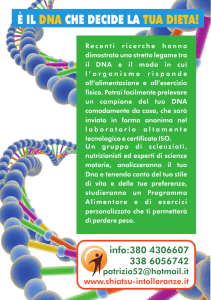
![mutazioni genetiche [al DNA] effetti evolutivi [fetali] effetti tardivi](http://s1.studylibit.com/store/data/004205334_1-d8ada56ee9f5184276979f04a9a248a9-300x300.png)
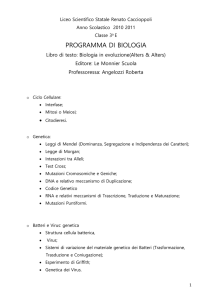
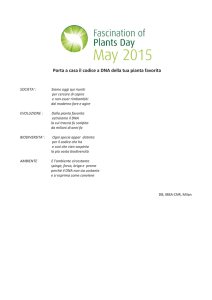
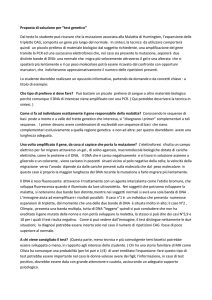
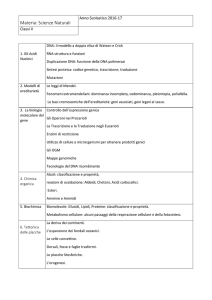
![(Microsoft PowerPoint - PCR.ppt [modalit\340 compatibilit\340])](http://s1.studylibit.com/store/data/001402582_1-53c8daabdc15032b8943ee23f0a14a13-300x300.png)
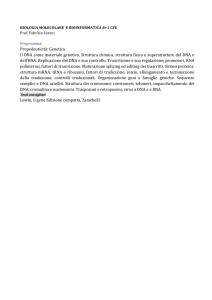
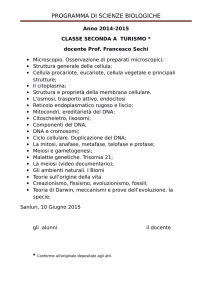

![Lezione 15 Virus [modalità compatibilità]](http://s1.studylibit.com/store/data/000771737_1-84b1cca561c5813066d1b76125338a98-300x300.png)